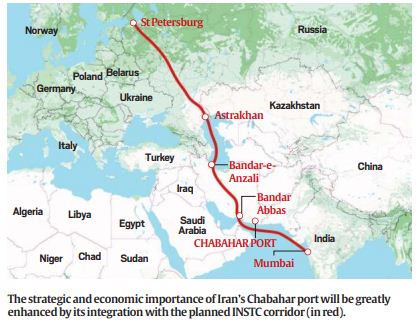May 14, 2024
India & Chabahar port: Recent development ,Significance & Challenges
Why in news ? India and Iran have recently signed a 10-year contract for the operation of a terminal at the strategically important Chabahar port in Iran.
What is Chabahar?
It is a deep water port in Iran’s Sistan-Baluchistan province. It is the Iranian port that is the closest to India, and is located in the open sea, providing easy and secure access for large cargo ships.

Sigificance for India:
Access to Afghanistan and Central Asia: Pakistan restricts land access for Indian trade with Afghanistan and Central Asia. Chabahar provides India with a bypass route, facilitating trade and investment in these regions.
Gateway to Eurasia: The port serves as a crucial link in the International North-South Transport Corridor (INSTC), connecting India to Europe through Iran and Central Asia. This reduces transportation costs and time for trade.
Energy Security: India can diversify its oil and gas import routes through Chabahar, lessening dependence on traditional sources.
Geopolitical Influence: Developing Chabahar strengthens India’s presence in the region and fosters ties with Iran, a key player in the Middle East.
Economic Development: The project creates jobs and opportunities for businesses in both India and Iran. It can also act as a hub for humanitarian aid distribution in the region.
Progress after 2015:
- While India spent about $100 million to construct a 218-km road from Delaram in western Afghanistan to Zaranj on the Iran-Afghan border to link with Chabahar, the port project itself progressed at a glacial pace. But things started to change in 2015 after talks between Iran and the P-5+1 bore fruit.
- About three weeks after Iran and the world powers announced their framework deal on April 2, 2015, and committed to finalising a comprehensive deal by the end of June, then Afghan President Ashraf Ghani visited India and stressed the importance of the Chabahar port.
- Over the next one year, coordination between the three countries led to the signing of a Trilateral Agreement to establish the International Transport and Transit Corridor in May 2016.
Recent Developments :
- India has so far supplied six mobile harbour cranes (two of 140-tonne and four of 100-tonne capacity) and other equipment worth $25 million.
- IPGL has been operating Chabahar port through its wholly owned subsidiary, India Ports Global Chabahar Free Zone (IPGCFZ), since December 24, 2018.
- The port has handled more than 90,000 twenty-foot-equivalent units (TEUs) of container traffic and more than 8.4 million metric tonnes (MMT) of bulk and general cargo since then.
- The port has also facilitated the supply of humanitarian assistance, especially during the Covid-19 pandemic.
- Till date, a total of 2.5 million tonnes of wheat and 2,000 tonnes of pulses have been trans-shipped from India to Afghanistan through Chabahar In 2021, India supplied 40,000 litres of the environment friendly pesticide (malathion) through the port to Iran to fight locust attacks.
Chabahar & INSTC:
Chabahar Port and the International North-South Transport Corridor (INSTC) are intertwined initiatives with significant strategic and economic benefits for India.
What is INSTC?
- The INSTC is a multi-modal transportation route aiming to connect the Indian Ocean and the Persian Gulf to the Caspian Sea and onward to Northern Europe. It involves transporting goods through a combination of sea, road, and rail networks.
How does Chabahar fit in?
Chabahar Port, located in southeastern Iran on the Gulf of Oman, acts as a critical entry and exit point for the INSTC in the Indian Ocean region.
Sea Link: Goods can be shipped from India to Chabahar Port, providing access to Iran and beyond.
Land Bridge: From Chabahar, cargo can be transported overland through Iran to Bandar-e Anzali on the Caspian Sea.
Caspian Sea and Beyond: Ships can then carry the goods across the Caspian Sea to ports in Russia and further on to Europe via railways.
Benefits of Chabahar for INSTC:
Faster Route: The INSTC route via Chabahar bypasses the Suez Canal, potentially saving up to 15 days on shipments between India and Europe.
Cost Reduction: Reduced transportation time translates to lower costs for businesses involved in trade between India, Central Asia, Russia, and Europe.
Connectivity Boost: Chabahar strengthens the INSTC’s viability, promoting increased trade flows and economic activity along the corridor.
Challenges:
US Sanctions: US sanctions on Iran can make it difficult for companies to invest in infrastructure and logistics required for smooth INSTC operations.
Regional Instability: Security concerns in Afghanistan and the broader region can disrupt the movement of goods along the corridor.
Developing Infrastructure: Upgrading infrastructure like roads and railways across Iran and Central Asia is needed to fully optimize the INSTC’s potential.
Chabahar serves as a strategic anchor for the INSTC in the Indian Ocean region. While challenges exist, successful development of both initiatives can significantly enhance India’s connectivity and trade prospects with Central Asia, Russia, and Europe.
January 30, 2025
January 20, 2025
January 14, 2025
